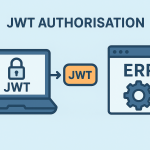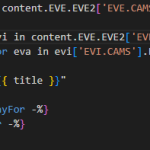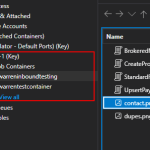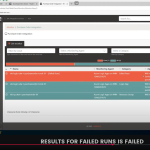- Validate then build the Office365 Connection
- And the same for the Logic App container with the following app settings
- In the Release Pipeline I used the Office365 artifact and the Logic App container artifact
- In the Release Pipeline Stage deployment, I do the following steps:
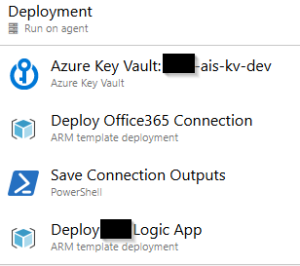
- Retrieve some Key Vault secrets that are required
- Deploy the Office365 connection and output the API details
steps: - task: AzureResourceManagerTemplateDeployment@3 displayName: 'Deploy Office365 Connection' inputs: azureResourceManagerConnection: 'company-ais-dev' subscriptionId: '1xx291x0-0x61-4xx1-9097-777x44x1xxxx' resourceGroupName: 'rsg-company-dev' location: 'UK South' csmFile: '$(System.DefaultWorkingDirectory)/Company.Azure.AIS.Common.Office365/Company.Azure.AIS.Common.Office365/azuredeploy.json' csmParametersFile: '$(System.DefaultWorkingDirectory)/Company.Azure.AIS.Common.Office365/Company.Azure.AIS.Common.Office365/azuredeploy.parameters.json' overrideParameters: '-environment dev' deploymentOutputs: connectionOutputs- Run a Powershell script to save the output variables into pipeline variables to be used in the Logic App container deployment
steps: - powershell: | ## connectionOutputs is already a pipeline variable returned via the ARM deployment ## task's deploymentOutputs attribute $armOutputObj = $env:connectionOutputs | convertfrom-json $armOutputObj.PSObject.Properties | ForEach-Object { $keyname = $_.Name $value = $_.Value.value ## Creates a standard pipeline variable Write-Output "##vso[task.setvariable variable=$keyName;]$value" ## Creates an output variable Write-Output "##vso[task.setvariable variable=$keyName;isOutput=true]$value" Write-Host "${keyName}: ${value}" } displayName: 'Save Connection Outputs'- Finally, use the Office365 API connection outputs to create the connection in the Logic App container
variables: office365connectionid: '' office365endpointurl: '' office365connectionname: '' steps: - task: AzureResourceManagerTemplateDeployment@3 displayName: 'Deploy VLE Logic App' inputs: azureResourceManagerConnection: 'company-ais-dev' subscriptionId: '1xx291x0-0x61-4xx1-9097-777x44x1xxxx' resourceGroupName: 'rsg-company-dev' location: 'UK South' csmFile: '$(System.DefaultWorkingDirectory)/Company.Azure.AIS.VLE.LogicApp/Company.Azure.AIS.VLE.LogicApp/azuredeploy.json' csmParametersFile: '$(System.DefaultWorkingDirectory)/Company.Azure.AIS.VLE.LogicApp/Company.Azure.AIS.VLE.LogicApp/azuredeploy.parameters.json' overrideParameters: '-environment dev -office365connectionid "$(office365connectionid)" -office365endpointurl "$(office365endpointurl)" -office365connectionname "$(office365connectionname)"'
"resources": [
{
"type": "Microsoft.Web/connections",
"apiVersion": "2016-06-01",
"name": "[parameters('name')]",
"location": "[parameters('locationName')]",
"tags": "[parameters('tags')]",
"kind": "V2",
"properties": {
"api": {
"id": "[concat('/subscriptions/',subscription().subscriptionId,'/providers/Microsoft.Web/locations/',parameters('locationName'),'/managedApis/office365')]"
}
}
}
],
"outputs": {
"office365connectionid": {
"type": "string",
"value": "[concat('/subscriptions/',subscription().subscriptionId,'/resourceGroups/',resourceGroup().name,'/providers/',reference(resourceId('Microsoft.Web/connections', parameters('name')),'2018-07-01-preview', 'full').resourceId)]"
},
"office365connectionname": {
"type": "string",
"value": "[parameters('name')]"
},
"office365endpointurl": {
"type": "string",
"value": "[reference(resourceId('Microsoft.Web/connections', parameters('name')),'2018-07-01-preview', 'full').properties.connectionRuntimeUrl]"
}
}steps:
- task: AzureResourceManagerTemplateDeployment@3
displayName: 'Validate ARM template'
inputs:
azureResourceManagerConnection: 'company-ais-dev'
subscriptionId: '1xf291x0-0x61-4xx1-9097-777x44x1xxxx'
resourceGroupName: 'rsg-company-dev'
location: 'UK South'
csmFile: src/Company.Azure.AIS.Common/Company.Azure.AIS.Common.Office365/azuredeploy.json
csmParametersFile: src/Company.Azure.AIS.Common/Company.Azure.AIS.Common.Office365/azuredeploy.parameters.json
deploymentMode: Validation
steps:
- task: PublishBuildArtifacts@1
displayName: 'Publish Artifact: Company.Azure.AIS.Common.Office365'
inputs:
PathtoPublish: src/Company.Azure.AIS.Common/Company.Azure.AIS.Common.Office365
ArtifactName: Company.Azure.AIS.Common.Office365
{
...
{
"name": "WORKFLOWS_SUBSCRIPTION_ID",
"value": "[parameters('subscriptionId')]"
},
{
"name": "WORKFLOWS_LOCATION_NAME",
"value": "[parameters('locationName')]"
},
{
"name": "WORKFLOWS_RG_NAME",
"value": "[parameters('resourceGroupName')]"
},
{
"name": "OFFICE365_CONNECTION_ID",
"value": "[parameters('office365connectionid')]"
},
{
"name": "OFFICE365_CONNECTION_RUNTIMEURL",
"value": "[parameters('office365endpointurl')]"
},
{
"name": "OFFICE365_CONNECTION_NAME",
"value": "[parameters('office365connectionname')]"
}
...
}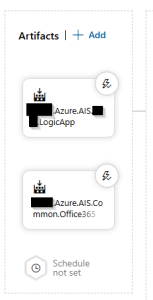
The connection in the Logic App will look like this:
{
"managedApiConnections": {
"office365": {
"api": {
"id": "/subscriptions/@appsetting('WORKFLOWS_SUBSCRIPTION_ID')/providers/Microsoft.Web/locations/@appsetting('WORKFLOWS_LOCATION_NAME')/managedApis/office365"
},
"authentication": {
"type": "ManagedServiceIdentity"
},
"connection": {
"id": "/subscriptions/@appsetting('WORKFLOWS_SUBSCRIPTION_ID')/resourceGroups/@appsetting('WORKFLOWS_RG_NAME')/providers/Microsoft.Web/connections/@appsetting('OFFICE365_CONNECTION_NAME')"
},
"connectionRuntimeUrl": "@appsetting('OFFICE365_CONNECTION_RUNTIMEURL')"
}
}
}So the connection is built up from the app settings, that were populated from the deployment of the actual Office365 Connection.
Therefore, the workflow actions will only need to reference the connection:
...
"connection": {
"referenceName": "office365"
}
...



